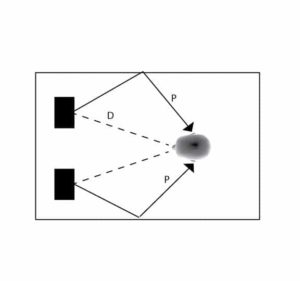Sound Reflections
Reflections have their own sound. They attach themselves to the direct sound from our sources, whether static or moving. Moving sources are impacted by objects in their pathway. Static sources such as studio or hi-fi playback speakers are placed inside a room with all of its room surface boundaries. The reflections contain analog information that intermixes with the direct sound, This blend of early and late reflections crosses our direct sound and that meshing process produces a sound energy that is favorable if managed properly. We must look at the amount and speed of both early and late reflections and what acoustic treatment technology we are going to use to manage this energy type.
Spaciousness
One of the first contributing factors to reflections is a term called spaciousness. Spaciousness or as in hi-fi circle jargon, “air”. It is the perceived space or distance between instruments and vocals in the sound scape created by our two stereo speakers. It is early and late reflection based. The acoustic goal is to make the music sound like it was played in the room, or better yet that there was no room at all. However, that is material for another discussion.
Image Changes
We can electronically manipulate a voice or instrument to either channel. We can fade it across channels and shift this image in many different electronic determined arrays. Well, guess what, so can the room. The reflections within that room. If we increase the reflections in the room to rise above a predetermined audibility threshold, the size and location of our direct image with vary. If we increase reflection rate above this point, we can get a more smearing of the direct sound.
Discreet Echos
If we increase pressure another 10 dB above the threshold determined to cause image shifting, we cross into the echo area. The reflections at this level produce their own discreet sound. The echo becomes is its own image. It can overpower the direct signal and distort every thing good and wanted in the direct sound where the direct sound is no longer recognizable. This must not be allowed to occur. The destruction is too great. Thankfully, existing absorption technologies do a good job of eliminating discreet echos.
Reflection Angle
Reflections occur off the walls, floor, and ceiling of our rooms. These reflections can be classified as early and late reflections based upon their time signature when compared with the direct sound. Angle of incident of these reflections is not that critical, except in one specific scenario. When we have a reflection that starts at the same location as our direct signal, reflection angle becomes more critical. The strength of the reflection can be elevated +5 – 10 dB louder than the direct before our auditory system can detect it. This occurs because of the masking of the reflection by the direct signal.
Different Spectrum
When measuring our rooms, we must make a few assumptions. First, we must assume that direct and reflective simulations are occurring in the same sonic spectrum. However, reflected energy takes on the characteristics of the surface area it strikes. After striking the surface area, parts of it are absorbed, some parts of the frequency spectrum much more than others. Higher frequencies are much more likely to be absorbed. This does not equate to the same spectrum in use for the comparison.
Lateral Reflections
Lateral or reflections from our side walls, contribute more than any other room surface to image shifting and spaciousness or “air”. Just a single, primary reflection from one side wall can cause these two things to move around and compress. One must find the time, delay, window that makes the image and sound stage all come together. Are we 10 ms. below the direct, 15 ms. and maybe even 20 ms.? Only experimentation and listening will determine. I have found one thing to be true. In managing these side wall reflections, the rate and level of the absorbing technology that is used, must be gradual and smooth up to 500 Hz. It is not advisable to absorb 100 % of any frequency below 500 Hz., contrary to what many manufacturers of sound absorbing technologies state.
Waves And Rays
Waves and rays are in our rooms. Waves, energy below 100 Hz., cycle through the air in our rooms and even go through the room itself. They don’t stay long but are like an acoustic bull in a china shop. They excite everything they can and cause much havoc. Rays, all energy above 100 Hz., fill the room and keep traveling from room surface to surface until they decay out. The reflections produced by all of this moving around contain and have an impact on our wanted direct sound from our loudspeakers. Reflections can impact spaciousness or “air” and image position. Certain reflection angles can produce even more distortions. Reflections must be manged in the time domain to reduce overall room reverberation times and image placement and position.
In Summary
I hope this explanation on the sonic signature of reflections helped. Please leave any comments below so I can get back to you. Don’t be afraid to hit those Facebook like, Google+ and Twitter buttons on the left hand side so other people can see this post. And if you want to learn more about this subject please sign up for our free room acoustic treatment videos and ebook which provide step by step instructions. Get instant access by signing up now.
Thanks
Mike









We use broadband absorption in the two most critical frequency regions in small rooms. Our Diaphragmatic absorbers, ACDA series, have…
Interesting web site and provocative introduction. Please check your copy for typos, otherwise nicely presented. I would like to see…
There is no such thing as soundproof anything especially carpet. Low frequency noise transmission requires a permanent construction fix with…
Hello Dennis! Our neighbors put a Ice Bath in their garage which is right below our bedroom and the Low…